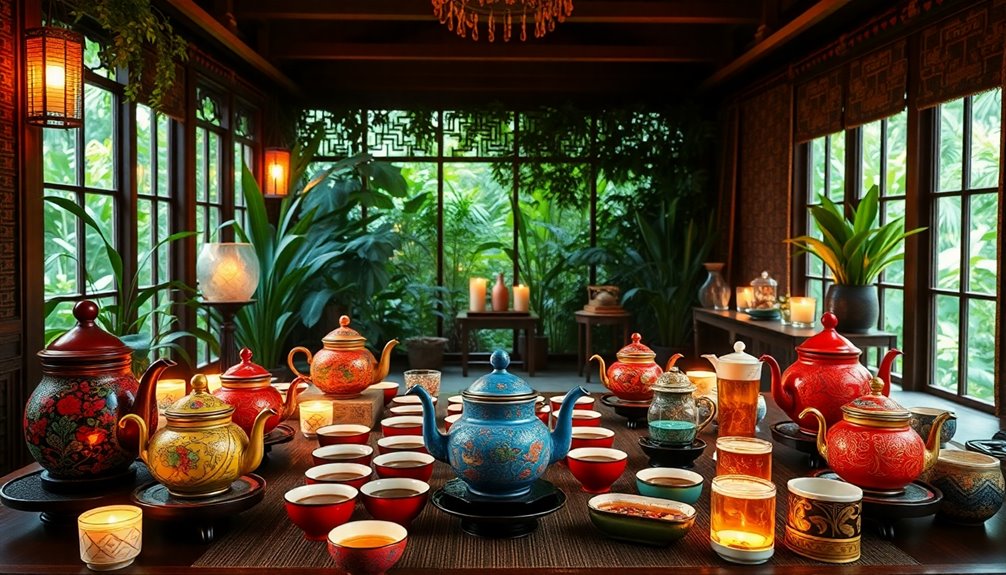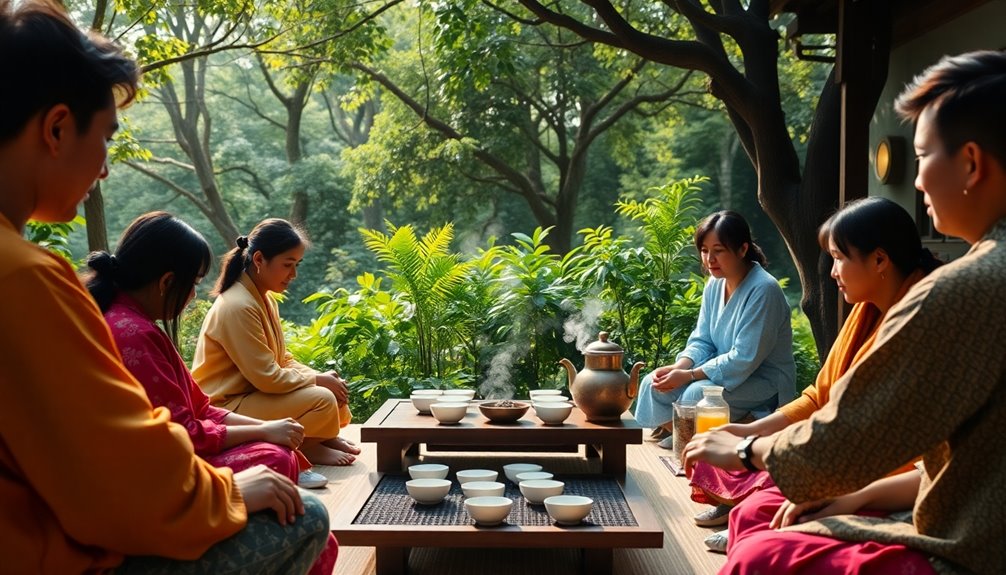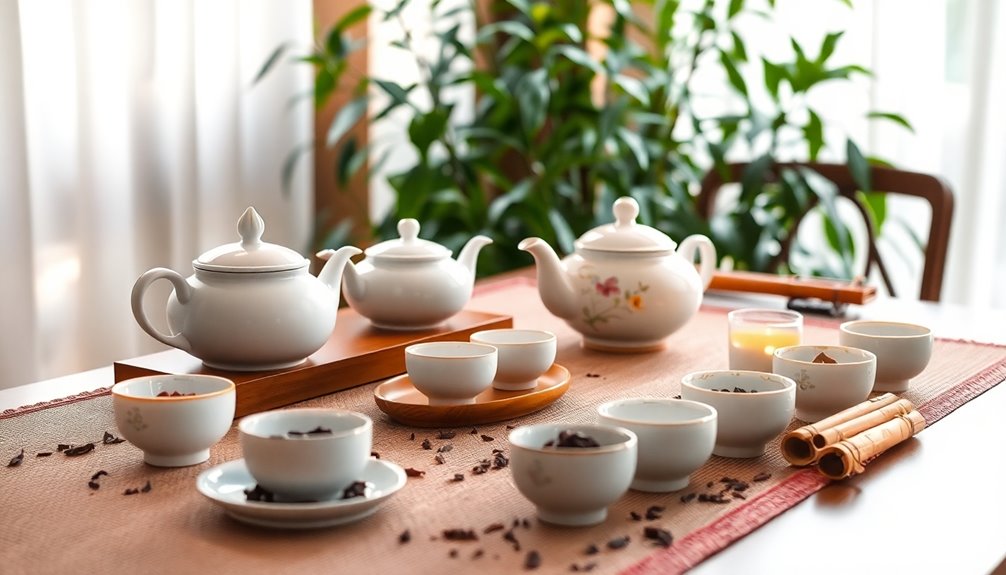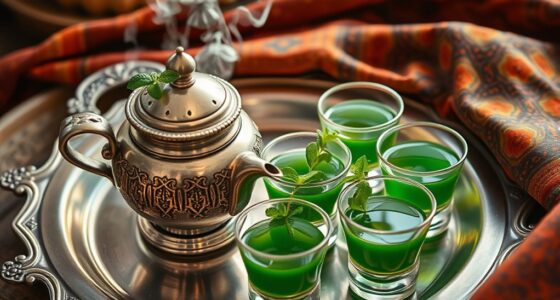Tea ceremonies can be quite extraordinary! One unusual example is the Welsh tea tradition, where sharing tea signifies hospitality and bonding. Welsh Breakfast tea, a mix of Assam and Kenya teas, is perfect with local treats like cheese scones. You might also enjoy the Darye tea ceremony in South Korea, featuring rice cakes that symbolize harmony. In Morocco, mint tea pairs beautifully with sweet pastries like baklava. Each of these ceremonies is steeped in cultural history and joy, making them special. If you're curious about more unique tea rituals from around the world, there's plenty more to explore!
Key Takeaways
- The Japanese Kuchikiri-no-chaji ceremony celebrates new beginnings with elaborate rituals and seasonal themes, enhancing the tea experience's significance.
- In Bhutan, the traditional butter tea ceremony features tea blended with yak butter and salt, reflecting the local culture and hospitality.
- The South Korean Darye ceremony combines tea with rice cakes, symbolizing harmony and balance in relationships and communal gatherings.
- In Morocco, the tea-pouring ceremony is an art form, where tea is poured from a height to create a frothy texture, enhancing the social experience.
- The Tibetan tea ceremony incorporates fermented tea with barley, showcasing the region's unique flavors and communal spirit during gatherings.
Introduction

Tea ceremonies around the world offer a fascinating glimpse into the diverse values and traditions of different cultures. Each tea ceremony is unique, reflecting the local tea culture and the people who participate in it.
For instance, Japanese tea ceremonies are some of the most well-known, emphasizing harmony, respect, and tranquility. In Japan, seasonal tea ceremonies like Kuchikiri-no-chaji celebrate the new year with rituals that might last up to four hours. They include elaborate meals and create a festive atmosphere.
Other ceremonies, such as Nagori-no-chaji, mark a bittersweet farewell to the previous year's tea leaves, showing how tea connects to the changing seasons and our experiences.
You might also enjoy informal gatherings, known as Chakai, where the focus shifts to relaxation and socializing. In these gatherings, friends come together to share traditional tea and light meals in a cozy setting.
Whether you're exploring the intricacies of a formal tea ceremony or enjoying a casual tea with friends, the beauty of these ceremonies lies in their ability to foster connection and appreciation for the moment.
Welsh Tea Set Traditions
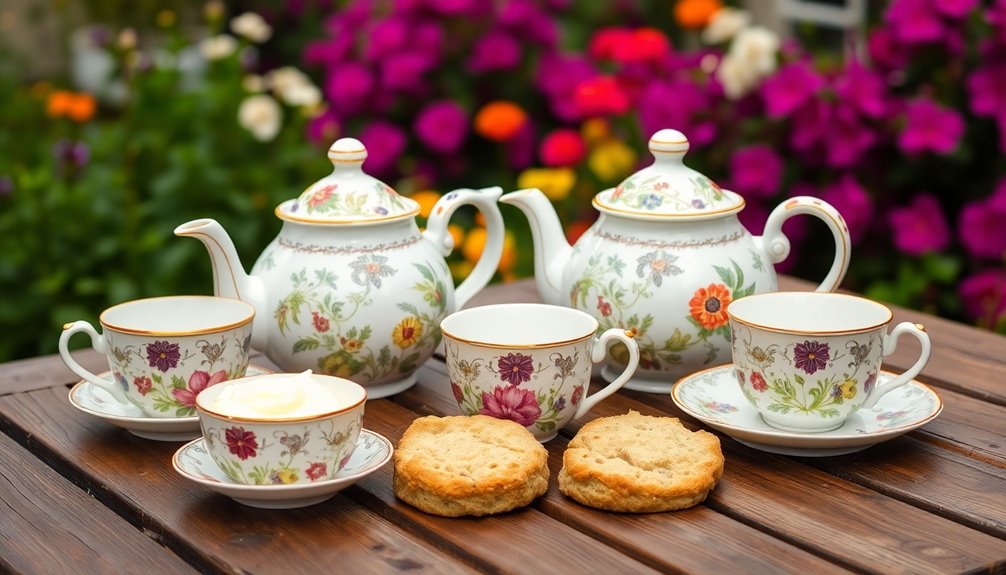
The act of sharing tea in Wales is all about hospitality.
No matter the occasion, you'll find that a warm pot of tea brings people together.
So, whether you're hosting a gathering or joining one, embrace the rich traditions of Welsh tea.
With each sip, you're not just enjoying a drink; you're partaking in a delightful journey through Wales' cherished culinary heritage.
Welsh Tea Blends and Pairings
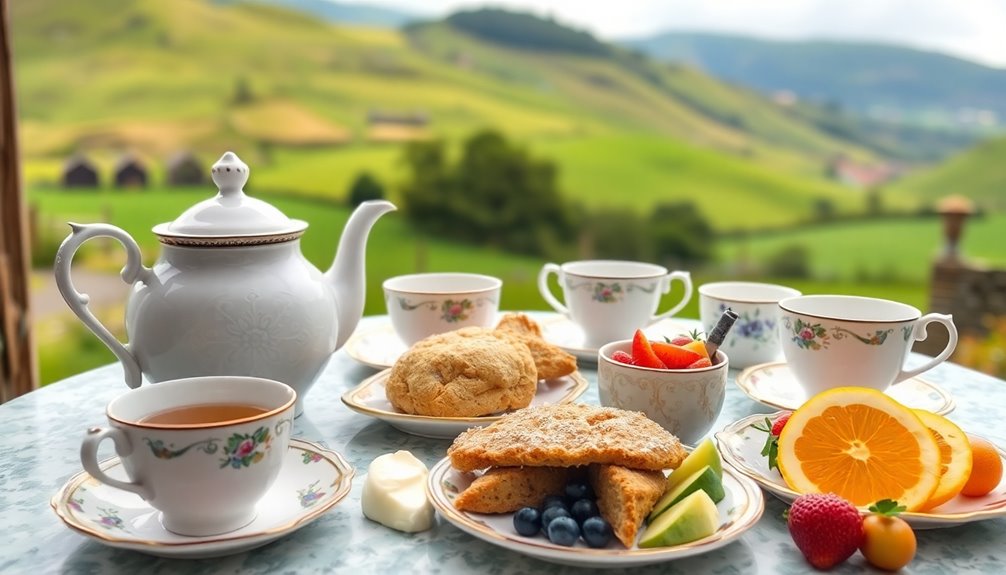
Welsh tea blends offer a delightful fusion of flavors that perfectly complement the region's culinary delights. In Wales, tea culture is rich and varied, featuring unique blends like Welsh Breakfast tea. This robust black tea combines Assam and Kenya teas, making it ideal for pairing with traditional treats like Welsh cakes or bara brith.
When you enjoy afternoon tea in Wales, expect a lovely spread of savory and sweet goodies. Cheese scones, fruit preserves, and pastries are often served alongside your tea. The use of locally sourced ingredients, such as honey from nearby hives and fresh herbs from local gardens, adds unique flavors to these blends.
If you prefer herbal tea, you're in luck! Infusions like chamomile and mint are popular, often served with a splash of lemon or ginger for added health benefits.
Welsh tea traditions emphasize hospitality, with friends and family gathering to share a pot of tea.
Tea-Infused Local Cuisine Pairings
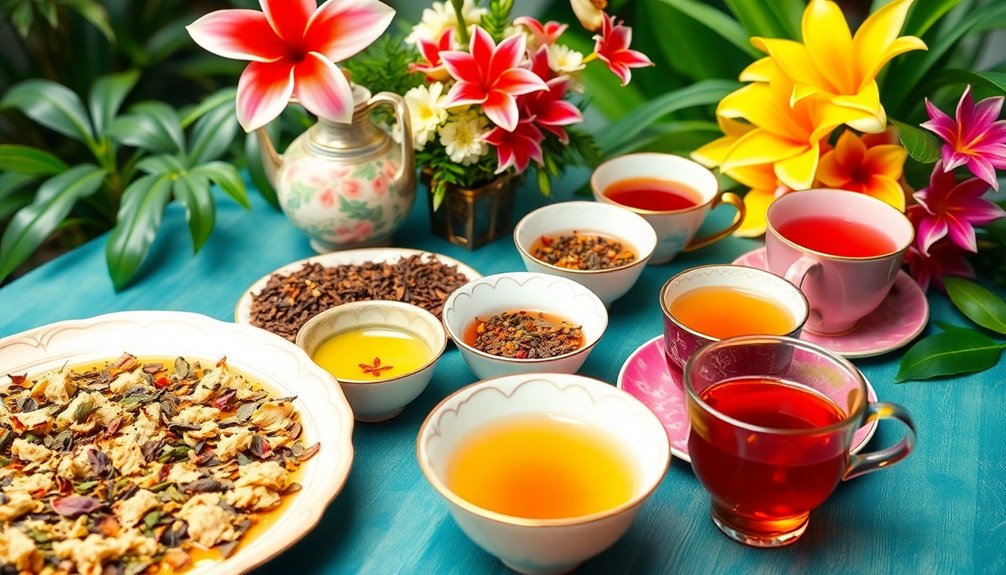
Exploring local cuisines through the lens of tea opens up a world of flavor pairings that enhance both dishes and brews.
In Japan, you'll find that matcha is a superstar in tea-infused cuisine. It adds a rich umami flavor to desserts like matcha ice cream and cakes, balancing their sweetness perfectly. Additionally, the use of vibrant colors in desserts complements the presentation, making them visually appealing.
In Thailand, the earthy tones of Northern Thai black tea work wonders with spicy curries and grilled meats, creating a delightful harmony.
Then there's Moroccan mint tea, often enjoyed with sweet pastries like baklava. The refreshing minty notes contrast beautifully with the sugary treats, making each bite even more enjoyable.
Let's not forget about yerba mate in Argentina! It pairs wonderfully with savory snacks like empanadas, where the herbal notes enhance the rich flavors of the fillings.
Lastly, in South Korea, the Darye tea ceremony includes traditional rice cakes, or tteok, which symbolize harmony. These delicate cakes blend perfectly with the tea's flavors, making the experience truly special.
Additionally, the cooling sensation of peppermint oil can enhance the tea experience by pairing well with various spicy or rich dishes, offering a refreshing counterbalance to the flavors.
Cultural Appropriation in Tea Practices
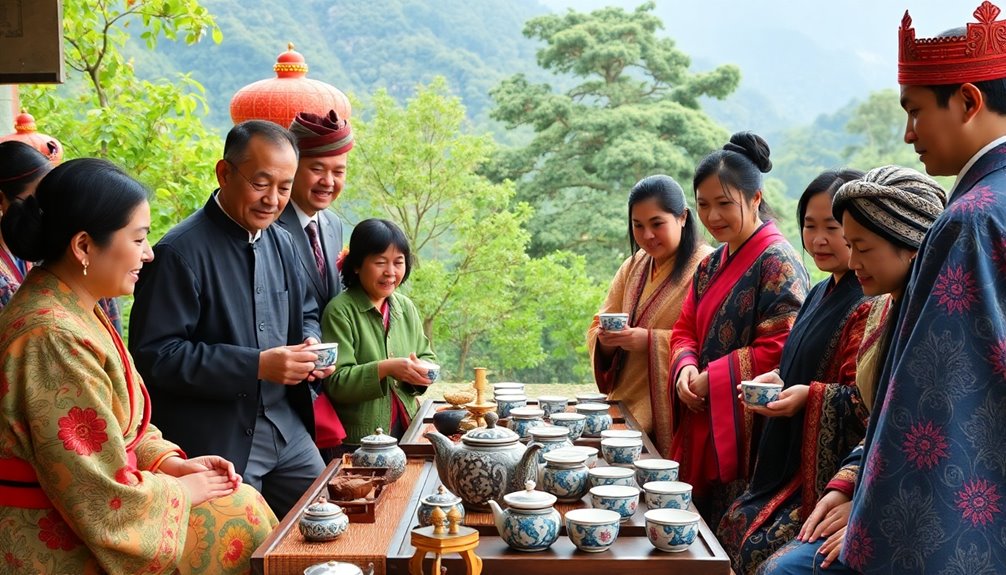
How can we appreciate the beauty of tea traditions without crossing the line into cultural appropriation? When we enjoy practices like the Japanese tea ceremony, it's essential to respect their cultural roots.
Cultural appropriation happens when people adopt elements from a culture without understanding their significance. This can lead to commercialization, where traditional tea ceremonies lose their original meanings.
For example, when Western tea houses offer modified versions of Japanese tea rituals, they often dilute the authentic experience. It's easy to forget that beverages like chai or matcha carry deep cultural stories. Ignoring these can perpetuate stereotypes and overlook their historical context.
To engage in respectful cultural exchange, take time to learn about the tea traditions you're interested in. Explore their origins and appreciate the values behind them.
Attend workshops or read books that explain the importance of these practices. By doing this, you not only show respect but also enrich your own understanding of tea's role in different cultures.
Practical Applications

Engaging with tea traditions can deepen your appreciation for the rich cultural tapestry they represent. As a tea drinker, you'll find that there are practical applications to these ceremonies that can enhance your everyday life.
For instance, consider hosting an Appalachian Tea Ceremony with friends. This monthly event encourages you to connect with nature and share stories, creating lasting bonds.
In the Japanese tradition, you could celebrate the Hatsugama ceremony. Boiling the first kettle of the year symbolizes new beginnings. It's a great way to learn about tea preparation while enjoying brewed tea with others.
You might also try seasonal ceremonies like Kuchikiri-no-chaji. Breaking the seal of a clay jar filled with tea leaves not only enhances flavor but also brings a festive spirit to your gatherings.
Frequently Asked Questions
What Are Some Interesting Facts About Tea Ceremonies?
Tea ceremonies showcase diverse cultural practices, from Japanese precision to Moroccan hospitality. Each ritual emphasizes connection, mindfulness, and community, reflecting unique regional adaptations. You'll discover fascinating traditions that enhance the appreciation of tea's rich history.
What Are the Different Types of Tea Ceremonies?
You'll discover various tea ceremonies worldwide, each with unique traditions. From Japan's Chanoyu promoting mindfulness to Morocco's sweet mint tea symbolizing hospitality, every ceremony offers a rich cultural experience that connects you with community and history.
What Is a Sacred Tea Ceremony?
A sacred tea ceremony emphasizes mindfulness and spiritual connection. You'll engage in meditative practices, reflect in a serene setting, and share personal stories, fostering community and deepening your awareness of the present moment.
What Are the Four Elements of the Tea Ceremony?
The four elements of a tea ceremony are the tea itself, the utensils for preparation and serving, the serene setting, and the participants. Each element enhances the experience, creating mindfulness and connection among everyone involved.
Conclusion
In conclusion, exploring unusual tea ceremonies can be a delightful adventure! From the vibrant Welsh tea traditions to unique local pairings, there's so much to discover. Remember to appreciate the cultural roots and practices behind each cup. You can even try these traditions at home with friends and family, making your own special memories. So, grab your favorite tea, invite some loved ones over, and start your own tea celebration today! Enjoy every sip!

